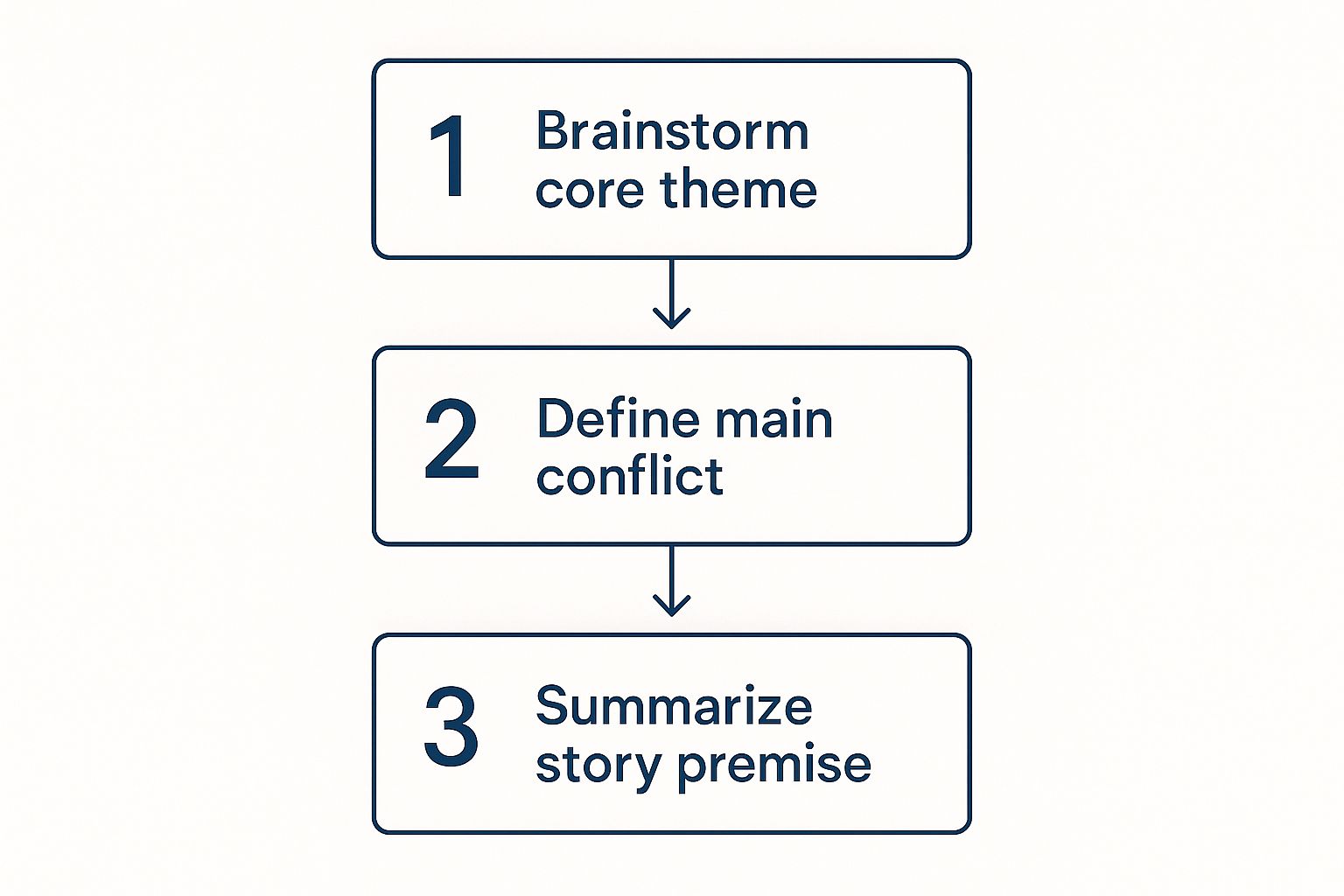Before you can write a compelling book, you need to know what you're trying to say. The first step is always to nail down your core idea. From there, you can start organizing it into a logical flow of parts, chapters, and the key scenes or arguments that will bring it to life. This framework is your strategic roadmap, and it’s what keeps your story coherent and engaging from the first page to the last.
Why Your Book Outline Is Your Most Important First Draft

I get it. A lot of writers, especially those just starting out, see outlining as a chore. They think it's a rigid set of rules designed to suck all the creativity out of the process. But ask any seasoned author, and they'll tell you the opposite is true. A good outline isn't a cage; it's the key that unlocks your story's true potential.
Think of yourself as an architect designing a skyscraper. You wouldn't just start pouring concrete and hope for the best, right? You'd need a detailed blueprint. The same exact principle applies to building a book.
Your outline is your first, and honestly, most critical, draft. It’s the stage where you find and fix major plot holes, figure out your character arcs, and structure your arguments before you've poured hundreds of hours into writing prose you might just have to delete later. That kind of foresight is what separates a finished manuscript from another forgotten project gathering dust on a hard drive.
The Strategic Advantage of a Solid Plan
Trying to write a book without an outline is like setting off on a cross-country road trip with a vague destination but no map. Sure, the idea is exciting, but you're almost guaranteed to face a journey full of wrong turns, dead ends, and a whole lot of wasted gas. An outline gives you a clear path forward by breaking an overwhelming task into small, manageable pieces.
This approach gives you a real sense of progress and accomplishment as you tick off each section. Instead of staring at a blank page and panicking about what comes next, you have a guide telling you exactly which scene to tackle or which point to argue.
Here’s how a plan gives you a serious edge:
- It Kills Writer’s Block: When you know where each chapter is heading, you can stop worrying about the plot mechanics and just focus on the creative act of writing.
- It Creates Cohesion: An outline ensures your beginning actually connects to your middle and end. No more dropped plot threads or characters whose motivations suddenly feel inconsistent.
- It Builds Narrative Momentum: You can intentionally place your plot twists, big reveals, and emotional high points to make sure your reader is hooked and can't put the book down.
A book outline transforms the abstract chaos of a great idea into a concrete, actionable plan. It’s not about limiting your creativity; it's about giving it the structure it needs to flourish and reach its full potential.
From Daunting Task to Empowering Process
Think about a complex thriller you've read, the kind with multiple timelines and a twist that left your jaw on the floor. That author didn't just stumble into that perfect reveal by accident. They planned it, meticulously, in the outline phase. The same goes for a non-fiction book that builds a powerful, persuasive argument—it works because the evidence and conclusions were laid out logically in the framework first.
The numbers don't lie. Authors who dedicate real time to outlining report a completion rate that is 30% higher than those who just start writing. What's more, books that were developed from detailed outlines tend to get 20% more reviews, which points to much stronger reader engagement. If you're curious, you can discover more insights about the book market and its trends. The data shows a clear link between planning and success.
Ultimately, learning how to write an outline for a book isn’t just about getting organized. It's a creative process that empowers you, reframing a monumental project into a series of achievable steps. It dramatically increases your chances of finally holding that finished book in your hands.
Finding the Right Outlining Method for Your Book
Figuring out how to outline your book isn't about finding a secret formula. The truth is, there isn't one. The best method really depends on what you're writing, your own creative habits, and just how complex your story or topic is. A thriller author needs a different kind of map than someone writing a step-by-step business guide.
Let's walk through some of the most popular and effective techniques out there. Once you get a feel for the strengths of each, you can pick the framework that will best support your vision and help you turn that idea into a finished book.
Popular Outlining Methods for Fiction Writers
For fiction writers, an outline is your blueprint for the emotional journey. It’s what gives your plot, character arcs, and pacing a solid structure to build upon.
Here are a few trusted methods I’ve seen work time and again:
- The Three-Act Structure: This is the classic for a reason. It cleanly divides your story into a Beginning (Act I), a messy, rising-action Middle (Act II), and a satisfying End (Act III). It’s perfect for making sure your story flows logically and hits all the crucial emotional beats.
- The Snowflake Method: Developed by Randy Ingermanson, this one is for writers who love to see things grow organically. You start with a single sentence, expand it into a paragraph, then build out character summaries, and eventually flesh it all out into a full scene list. It's a fantastic way to construct a complex world from a single, potent idea.
- The Beat Sheet: Borrowed from the world of screenwriting, a beat sheet zeroes in on the most critical moments—the "beats"—of your story. This approach is all about pacing. It ensures your inciting incident, midpoint twist, and climax land at just the right moments to keep readers hooked.
Sometimes, the best way to get started is to see how others do it. Looking at a few project outline example templates can give you a major spark of inspiration for structuring your own work.
Effective Outlining Techniques for Non-Fiction Authors
When it comes to non-fiction, outlines are all about creating clarity and delivering value. The main goal is to organize your information so that it's persuasive, comprehensive, and incredibly easy for your reader to follow.
Here are a few approaches that work well for non-fiction:
- Mind Mapping: This is a wonderfully visual technique, especially in the early brainstorming phase. You just put your central topic in the middle of a page and start branching out with related ideas, chapters, and supporting facts. It helps you discover connections you might have otherwise missed.
- The Topical Outline: This is the traditional, hierarchical method most of us remember from school—think Roman numerals, letters, and numbers. It’s ideal for books packed with information, like a textbook or a detailed how-to guide, because it ensures every point has a logical place.
- The Argument-Based Outline: If you're writing to persuade, this is your go-to. You start with your core thesis and then design each chapter to build your case, piece by piece. You’ll present evidence, tackle counterarguments, and guide the reader straight to your conclusion.
This simple infographic below shows a great starting point that works with any of these methods: nailing down your theme, defining the core problem, and summarizing the premise.

This flow really highlights an important truth: a solid outline always begins with a crystal-clear understanding of your book's core purpose before you get lost in the weeds.
Which Book Outlining Method Is Best for You?
To help you decide, here's a quick breakdown of these common methods and where they shine.
Comparison of Popular Book Outlining Methods
| Method | Best For | Primary Focus |
|---|---|---|
| Three-Act Structure | Plot-driven fiction, screenplays | Narrative momentum and pacing |
| The Snowflake Method | Complex novels with deep world-building | Building from a core concept outward |
| The Beat Sheet | Thrillers, mysteries, fast-paced stories | Hitting key plot points at the right time |
| Mind Mapping | Brainstorming any genre, visual thinkers | Exploring connections and initial ideas |
| Topical Outline | Textbooks, how-to guides, reference books | Logical organization and clarity |
| Argument-Based Outline | Persuasive non-fiction, business books | Building a compelling, evidence-based case |
Ultimately, the "best" method is the one that clicks for you. Many successful authors I know actually mix and match, creating a hybrid system that fits their unique style. If you want to explore narrative frameworks further, our own https://barkerbooks.com/story-structure-template/ can be a really helpful resource for organizing your plot.
The most effective outlining method is the one you will actually use. Don't get bogged down trying to find the "perfect" system. Experiment with a few, see what feels natural, and choose the one that helps you move from idea to execution.
If you're a "pantser" who likes to discover the story as you write, a minimal beat sheet might be just enough to give you direction. If you're a "plotter" who needs every detail mapped out, a comprehensive topical outline or a full Snowflake will give you the confidence to write freely. It’s all about finding that sweet spot that supports your creative process instead of strangling it.
How to Build Your Outline from Idea to Chapter Plan

Alright, this is where a great idea starts to feel like a real book. You’re moving from that initial flash of inspiration to a concrete, chapter-by-chapter plan. The whole point is to move from the big, blurry picture into sharp focus.
Think of your outline as a living document, not a contract set in stone. It’s there to guide you, not to box you in. So, let’s get into the nuts and bolts of building one.
Start with Your Core Premise and Theme
Before a single chapter gets a name, you need to nail down the absolute foundation of your book. Everything you write will be built on this, so it has to be rock-solid.
First, your core premise. Can you summarize your book in a single, compelling sentence? For a novel, this is your protagonist, their goal, and what's standing in their way. For non-fiction, it's the core problem you're solving for the reader.
Next up is the central theme. What’s the big idea you want people to walk away with? Is your story about forgiveness? Is your guide about empowerment through financial literacy? Knowing this keeps every chapter and every argument pointed in the right direction.
And finally, who are you writing for? Your target reader dictates everything—your tone, your vocabulary, the stories you tell. Writing for a CTO is a world away from writing for a first-time manager.
Break Your Book into Larger Sections
With the foundation in place, zoom out. Don’t get bogged down in chapter-level details just yet. Instead, think in bigger chunks, like "Parts" or "Acts." This high-level view is what gives your book a logical flow and a satisfying rhythm.
How this looks in practice depends on your genre:
- For Fiction: The classic three-act structure is your best friend. Act I sets the stage and kicks off the action. Act II is the messy middle where all the conflict happens. Act III delivers the climax and resolution.
- For Non-Fiction: Think in logical stages. Part 1 could set up the problem. Part 2 might dive into your core methodology. Part 3 could be all about practical application, with case studies and step-by-step instructions.
This birds-eye-view keeps you from getting lost in the details too soon. It’s the skeleton. Now, you’re ready to add the muscle.
An outline is a dynamic tool, not a static one. I can't stress this enough. It should change and grow as you write and uncover new ideas. Give yourself permission to scribble notes, ask questions in the margins, and move things around.
Drill Down into Individual Chapters
Now you can start slotting in the chapters. Take each of those big sections you just mapped out and break them down into their component chapters. This is where you connect the high-level structure to the page-by-page reading experience.
Don’t aim for perfection here. Just give each chapter a clear job to do. In a non-fiction book, one chapter might be dedicated to a single core concept. In a novel, a chapter might contain a couple of key scenes that push the plot forward.
Most authors I know tend to land in the 10 to 15 chapter range. But here’s a telling statistic from industry surveys: writers who create detailed outlines (think 1,500 to 3,000 words) often draft their manuscripts up to 40% faster and face significantly less rewriting. That time you invest in planning now pays off massively later.
Flesh Out Each Chapter with Key Details
You have your chapter list. The final step is to breathe some life into it. For every chapter, write a short summary or a few bullet points covering the key events, arguments, or information it needs to contain.
This is the most granular part of the process, and it’s arguably the most important. The more detail you add here, the less you'll stare at a blank page later. When you feel stuck, you can just look at your outline and see exactly what needs to happen next.
Here’s a quick checklist for each chapter:
- A Working Title: Give it a simple, descriptive label (e.g., "The Meeting in the Rain" or "Chapter 4: The Impostor Syndrome Myth").
- Key Plot Points or Arguments: What are the 3-5 non-negotiable things that must happen or be explained in this chapter?
- Character Moments: Note any introductions or major development arcs for your characters.
- Setting & Tone: Where are we? What should it feel like? (e.g., "Tense boardroom meeting" or "Hopeful, sunrise over the city").
- Research Notes: Jot down facts to check, experts to cite, or questions you still need to answer.
Building out this level of detail turns a simple list into a powerful roadmap. To see how it all comes together, take a look at this complete example of a book outline. Sometimes seeing a finished one makes all the difference. This plan is your best defense against writer's block and the secret to a book that hangs together beautifully.
Modern Outlining Tools and Software for Writers
There’s a certain romance to the image of an author scribbling on index cards, surrounded by stacks of notebooks. I get it. But let’s be honest—today’s writers have a powerful arsenal of digital tools that can make outlining faster, more flexible, and a whole lot more effective.
The trick is finding a tool that clicks with how you think. Some of us thrive with visual, almost chaotic mind maps, while others need the clean, structured environment of a dedicated writing app. There's no single "best" option here, only the one that helps you turn a jumble of ideas into a solid plan with the least amount of friction.
Dedicated Writing and Outlining Apps
For authors who want their outline and manuscript to live in the same house, dedicated writing software is a complete game-changer. These apps are built specifically for the long-haul journey of writing a book.
Two of the heavyweights are Scrivener and Ulysses. They let you build your outline using a "corkboard" of virtual index cards or a simple nested list. Then, you can write each scene or chapter right there within that structure. Your outline isn't a separate document; it's the very backbone of your manuscript, always just a click away.
Here’s a look at the Scrivener interface. Notice how the outline on the left directly corresponds to the writing space on the right.
This integrated approach means you can drag-and-drop chapters, split scenes in two, or just get a bird's-eye view of your progress without ever leaving the app. For many writers, this is the most seamless way to build a plan and then bring it to life. If you're curious about other options, our guide on essential writing tools for authors explores a wider variety of software.
Visual and Flexible Planning Tools
What if a linear list just makes your brain shut down? If you're a visual thinker, tools like digital whiteboards and mind maps are your best friend.
Platforms like Miro or Milanote give you an infinite canvas to play with. You can brainstorm ideas, draw out complex character webs, storyboard your plot points, and connect everything with arrows, colors, and notes. This method is brilliant for those messy, early stages when you're still figuring out how all the pieces of your story even fit together.
I find these tools especially useful for:
- Mind Mapping: Start with your core premise in the center and branch out with characters, subplots, and themes. You’ll be surprised at the connections you uncover.
- Storyboarding: Create a visual sequence of scenes to nail your pacing before you've written a single word of prose.
- World-Building: Keep your maps, character sketches, and historical timelines for a sprawling fantasy or sci-fi epic all in one, easy-to-scan place.
For those who get really deep into organization, you can even implement systems like the P.A.R.A. Folder Structure to manage research, notes, and character profiles within these flexible tools.
The Rise of AI in Book Outlining
Artificial intelligence has recently thrown a fascinating new variable into the mix. AI writing assistants can act as a creative sparring partner during the outlining phase, helping you brainstorm chapter titles, flesh out a character's backstory, or structure a non-fiction argument.
The AI book writing market, now valued at USD 2.8 billion, shows just how quickly this is catching on. These tools use natural language processing to help authors organize themes and research, with some writers reporting they can cut their outlining time by up to 50%. You can read the full research about the AI book writing market to see how much this technology is growing.
The goal isn't to have AI write your outline for you. Think of it as a collaborator. It can help you smash through writer's block and explore structural possibilities you might never have considered on your own, making the whole process feel much more interactive.
Common Outlining Mistakes and How to Avoid Them

Learning how to write an outline for a book is a huge step, but even with the best intentions, it's easy to go astray. Your outline should be a trusty map, not a creative straitjacket. It’s supposed to prevent frustration, not cause it.
Let's walk through some of the most common pitfalls I see writers fall into and, more importantly, how you can sidestep them to keep your project moving forward.
One of the biggest traps is over-outlining. This is where you plan every single detail with such rigid precision that there’s zero room for discovery when you actually start writing. You've mapped out every line of dialogue and every minor character's twitch, turning the creative process into a sterile paint-by-numbers exercise.
When your outline is that prescriptive, it just kills the spontaneity and joy of writing. The fix? Focus your outline on the big picture. Nail down the major plot points, the core character arcs, and the thematic beats, but leave the smaller, granular details to be discovered on the page.
The Danger of Under-Outlining
Of course, the opposite problem is just as damaging. Under-outlining happens when your plan is so sparse it offers no real guidance. You might have a killer opening, a vague idea for the middle, and a brilliant ending, but you'll almost certainly hit a wall a few chapters in, staring at a blank screen and wondering what comes next.
This is a classic recipe for writer's block. To avoid it, make sure your outline includes these absolute essentials:
- A Clear Inciting Incident: The event that kicks the whole story off.
- Major Turning Points: Key moments that escalate the conflict and force your protagonist to change direction.
- A Climax: The ultimate showdown where the central conflict comes to a head.
- A Resolution: The aftermath that shows the consequences of that climax.
Think of this as your safety net. It gives you clear signposts to write toward without dictating every single step of the journey.
Don't confuse structure with rigidity. An effective outline provides a framework, but it must be flexible enough to evolve as your story and characters reveal themselves to you during the writing process.
Getting Stuck in Perpetual Planning
Here’s another one I see all the time: falling in love with the planning process itself. You spend weeks, even months, perfecting your outline, creating elaborate character bibles, and building intricate worlds. It feels productive, but it often becomes a sophisticated form of procrastination, preventing you from ever starting the actual manuscript.
The solution is simple but hard: set a firm deadline for your outlining phase. Whether it's one week or one month, commit to it. Once that date hits, you start your first draft. Period. Remember, the outline is a tool to help you write, not a replacement for it. Your plan will never be perfect, and that's okay.
Forgetting About Pacing and Character Arcs
Many new writers focus so heavily on the sequence of events—the plot—that they completely forget two of the most crucial elements that make a story compelling: pacing and character development. A fantastic plot can fall completely flat if all the exciting moments are crammed together or if the main character is the exact same person at the end of the book as they were at the beginning.
As you build your outline, consciously map these elements out:
- Narrative Pacing: Deliberately alternate between high-tension scenes and moments of quiet reflection. Give your reader (and your characters) time to breathe and process what just happened.
- Character Arcs: For each major character, ask yourself: How do they change by the end of the book? Pinpoint the key moments in your outline where they learn a lesson, overcome a flaw, or have a significant realization.
By weaving these elements directly into your chapter summaries, you ensure your story has both a strong plot and deep emotional resonance. This is how you transform your outline from a simple sequence of events into a true blueprint for a captivating narrative.
Answering Your Top Book Outlining Questions
Even the most seasoned writers have questions when they sit down to map out a new book. It’s all part of the process. Let’s clear up a few of the most common hurdles you might encounter so you can get back to building your story.
How Long Should a Book Outline Be?
There’s no right or wrong answer here—it really comes down to what kind of writer you are. If you’re a "pantser" who thrives on discovery, a single page of bullet points covering the major plot turns might be all you need. It’s just enough to give you a direction without boxing you in.
On the other hand, if you’re a "plotter" building an epic fantasy with multiple subplots, your outline could easily stretch to 20 or 30 pages. For non-fiction, a solid approach is to write a detailed paragraph summarizing what each chapter will cover.
Your outline should be a tool that serves you. It needs to be detailed enough to keep you on track, but flexible enough that it doesn’t kill your creativity.
What if My Story Changes While I'm Writing?
Good! That means you're discovering your story on a deeper level. It’s not just okay for things to change; it's practically a guarantee. Characters have a funny way of developing minds of their own, and a new idea that pops up mid-sentence is often a hundred times better than what you originally planned.
Think of your outline as a living, breathing document, not a contract set in stone. When your story takes an exciting new turn, just pop back into your outline and adjust it. This keeps your guide relevant and genuinely helpful, rather than an abandoned relic from your initial brainstorm.
Can I Outline My Book After I’ve Written the First Draft?
Yes, and you absolutely should. This is a brilliant editing strategy called a reverse outline, and it's a lifesaver for taming a chaotic first draft. Once the messy, creative part is done, you go back and create an outline based on what you actually put on the page.
A reverse outline is fantastic for spotting problems you're too close to see otherwise. It helps you:
- Pinpoint Plot Holes: See exactly where the story's logic falls apart.
- Diagnose Pacing Problems: Instantly notice if you have three slow chapters bogging down the middle.
- Refine Character Arcs: Track a character’s journey from start to finish to ensure it's believable and consistent.
Many writers—especially pantsers—swear by this method. It lets them get the story out in a creative rush and then find the structure afterward, making the revision process far more focused and effective.
Ready to turn that polished outline into a book people can hold? The expert team at BarkerBooks can guide you through every step, from professional editing and cover design to worldwide distribution. Start your publishing journey today.
